Which birds might I see today? Bald Eagles
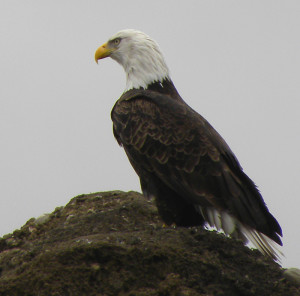
In our valley, winter is one of the best times to see Bald Eagles but did you know that the Kelowna landfill is one of the best places to see them? Every January members of the Central Okanagan Naturalists’ Club conduct a survey of numbers of both eagles and swans, with the dump being a prime viewing opportunity for the volunteers who take part. One January I counted twelve eagles there!
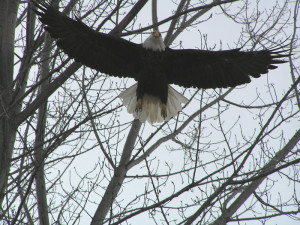
Bald Eagles are, of course, easily recognized even by non-birders. With their large size and the distinctive white head and tail they have an obvious presence both in the skies and perched. Their bodies are over 30” long / .75 metre but it is the wings that most impress, reaching out like planks in the sky to an impressive 6’ 6” / 2 metres. Eagles soar overhead with their wings almost flat, and when they actively fly their wingbeats are floppy and slow, very like that of a Great Blue Heron.
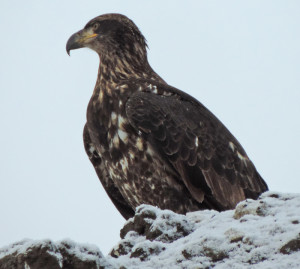
It takes four to five years for eagles to reach full breeding maturity with the familiar white head and tail. First year birds are very dark all over, second year birds are more mottled showing much more white on back, belly and wings, while third year birds have a dark eyestripe accented by white above and below the eye. The enormous beak gradually changes colour from black to bright yellow as the bird matures. Female eagles are slightly larger than males.
Bald Eagles build large obvious nests of sticks and vegetation, deeply lined with finer materials and maintain them for many years. Their nest is “a durable playpen” for the young, which do not all hatch at the same time. It is not uncommon for the youngest to die, and often only one or sometimes two chicks are raised. Bald Eagles mate for life and both tend the nest and feed the young. What do they eat? Their favourite food is fish, especially salmon, often dead or dying, but they also take small mammals or birds, especially water birds such as coots.
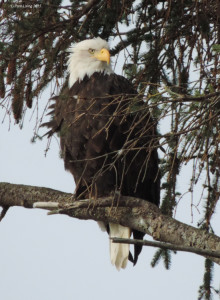
You will often see Bald Eagles in winter sitting in a lakeside tree watching a raft of American Coots, probably picking out which one to attack for lunch! It’s exciting to watch the flurry when the eagle finally makes the attempt.
I mentioned the birds’ fondness for salmon. Many of you will know of the huge concentration of Bald Eagles at Brackendale near Squamish, and other coastal points in British Columbia and Alaska, where eagles come to feed on spawning salmon. They can be seen in the hundreds at times. It has been shown that some of the birds come from as far away as the mid-western United States and Canada’s prairie provinces to join the feast. When you think about it, it is remarkable that such a bird leaves an area where water bodies are frozen for much of the winter months, flies several hundred kilometres or more, and reaches the coastal river mouths to fatten up on the plentiful supply of fish. Obviously the expenditure of effort is more than compensated for by the abundance of the food. But how do they know? And how do they know when?
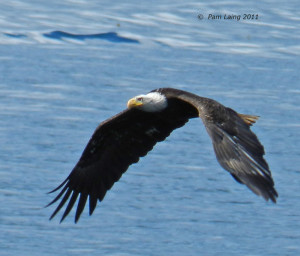
The national emblem bird of the U. S., the Bald Eagle, is not really fierce, merely opportunistic, but always thrilling to see. I love living somewhere where Bald Eagles are an abundant presence. So if you have occasion to visit the Kelowna landfill or the Okanagan lakeshore during the winter months, keep your eyes open for these majestic birds, patiently waiting for a starling or coot for a mid-day snack, or a gull that can be harassed into dropping something edible.
Pam Laing, Okanagan birder







0 Comments